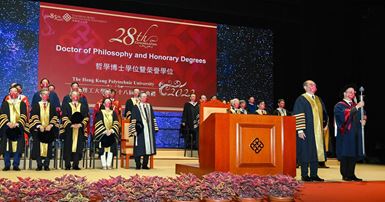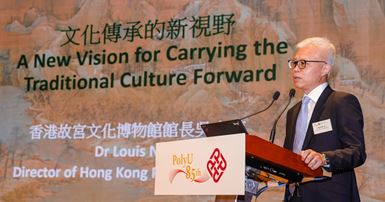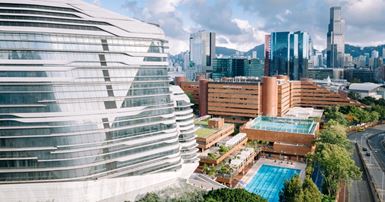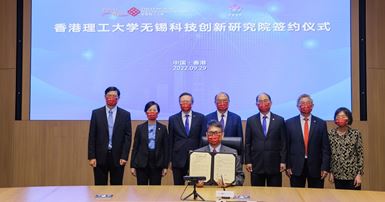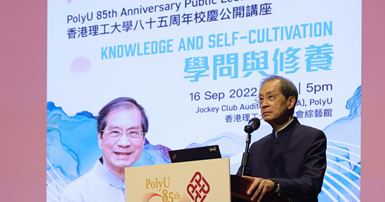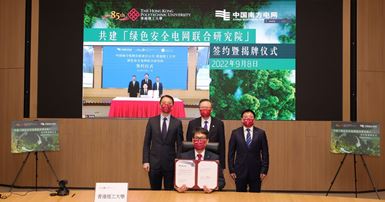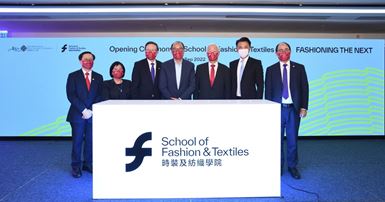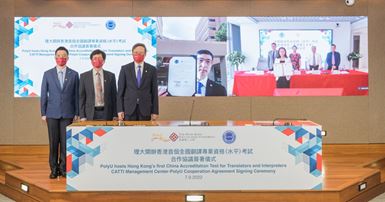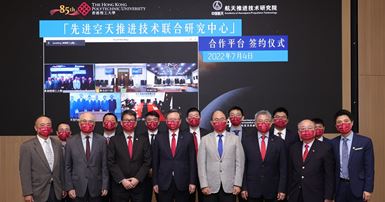PolyU and Wuxi city government to set up pioneering research institute to drive innovation and technology development in Yangtze River Delta
The Hong Kong Polytechnic University (PolyU) and the city government of Wuxi, Jiangsu province, have reached an agreement to jointly set up the PolyU-Wuxi Technology and Innovation Research Institute – a pioneering move among Hong Kong’s tertiary institutions to establish a scientific research institute in Wuxi and participate in the Yangtze River Delta’s innovation and technology (I&T) drive.
The new institute will foster I&T collaboration between government, industry, academia, and research institutions through the provision of an advanced research platform, a unique engineering doctorate programme, and incubation support backed by a robust local manufacturing sector. The PolyU-Wuxi collaboration will also contribute to the Nation’s I&T development.
The cooperation agreement was signed today by Prof. Christopher CHAO, Vice President (Research and Innovation) of PolyU and Mr ZHANG Jinwei, head of Xinwu district, Wuxi, in a video conference and witnessed by Dr LAM Tai-fai, Council Chairman of PolyU; Prof. Jin-Guang TENG, President of PolyU; Mr DU Xiaogang, Communist Party Secretary of Wuxi; Mr ZHAO Jianjun, Deputy Party Secretary and Mayor of Wuxi, and other leaders of PolyU and the Wuxi authorities.
The partnership underscores a synergy between Wuxi’s economic strength and PolyU’s world-leading education and research excellence. It also reinforces collaboration among Jiangsu province, Hong Kong and Macau encouraged by national policies.
The five-year cooperation agreement will come into effect from January 2023. The Faculty of Engineering of PolyU and the Wuxi National Hi-tech District will join forces to set up the Institute in phases. The Institute, located at the Wuxi Airport Economic Development Zone, comprises a teaching and research facility for the engineering doctorate programme, an advanced research platform for cutting-edge technologies, and an innovation hub for translational research and incubation of start-ups.
Prof. H. C. Man, Dean of Faculty of Engineering of PolyU, explained that the PolyU-Wuxi Technology and Innovation Research Institute serves to:
Establish a world-class advanced research and innovation platform
The Institute will focus on the research and development of core technologies with proprietary intellectual properties in the areas of aerospace, biomedical technology, advanced manufacturing, new materials, artificial intelligence, telecommunication, and new energy. It aspires to be a hub of innovative minds through the promotion of joint research, academic exchange, co-incubation, and knowledge transfer.
Nurture I&T talents
A PolyU engineering doctorate programme uniquely designed for working professionals, as well as a post-doctoral engineering programme, will be rolled out by the Institute to nurture a Wuxi-based I&T talent pool. Candidates will be required to use their employers’ projects on tackling critical technological challenges as their thesis topics. They will also study business management and entrepreneurship in the programme to prepare themselves to be future I&T industry leaders.
Fostering emerging industries
The Institute will provide translational and entrepreneurial opportunities and render support to PolyU researchers to collaborate with Wuxi’s corporates and manufacturers to commercialise research outcomes. This will in turn promote the local development of emerging industries and spur breakthroughs in engineering technologies as well as their application. The Institute aims to nurture champions in emerging industries in three to five years.
The Wuxi Municipal Government will provide the required facilities, infrastructure and funding in the next five years to support PolyU in developing this research institute. The two parties will also arrange for industry professionals from Wuxi and the Yangtze River Delta region to come to Hong Kong every year for exchange.
Last year, PolyU established the Jiangsu-Hong Kong-Macao University Cooperation Alliance and signed a memorandum of understanding on cooperation in basic science and technology research with the Jiangsu Institute of Industrial Technology. Coupled with Wuxi's vigorous economic and industrial development, this cooperation with PolyU opened up an unprecedented chapter in "government, industry, academia and research" collaboration among the two parties.
Dr Lam Tai-fai said: “Jiangsu province is an important province in the Yangtze River Delta region, and Wuxi enjoys a strong reputation for its comprehensive industrial development. PolyU has been actively engaged in strategic technology and innovation research cooperation with Jiangsu, and we are committed to contributing to the development of talents as well as innovation and technology research. With the integration of our excellence in education and research, PolyU is very pleased to work with the Wuxi government to strengthen the strategic cooperation between Jiangsu, Hong Kong and Macau to establish the Institute. PolyU will continue to strive to achieve excellence in the development of education, research and innovation.”
Prof. Jin-Guang Teng said: “PolyU and the Wuxi government share a common vision for the future: we both strive to strengthen our cooperation in the cultivation of high-quality professionals and advanced technological innovation, ultimately contributing to the economic development of Wuxi, Jiangsu and the Nation. PolyU sees great importance in basic research, as well as applied and translational research. Through leveraging the platform of the Institute, we hope to match PolyU's research excellence with the industrial needs of Wuxi to deliver impactful outcomes.”
Mr Zhao Jianjun said: “The successful establishment of the PolyU-Wuxi Technology and Innovation Research Institute marks another important partnership between the ‘Pearl of Taihu’ and the ‘Pearl of the Orient’, which is a strong impetus for the further development of cooperation among Jiangsu, Hong Kong and Macao. The two parties will seek new heights in technology and innovation and foster new emerging industries, through integrating PolyU’s education and research excellence with Wuxi’s economic and industrial power. Wuxi will provide the best service and maximum support for the cooperation between the two parties, and together we will work to create a new benchmark for government-academia cooperation between the Yangtze River Delta and the Greater Bay Area."
